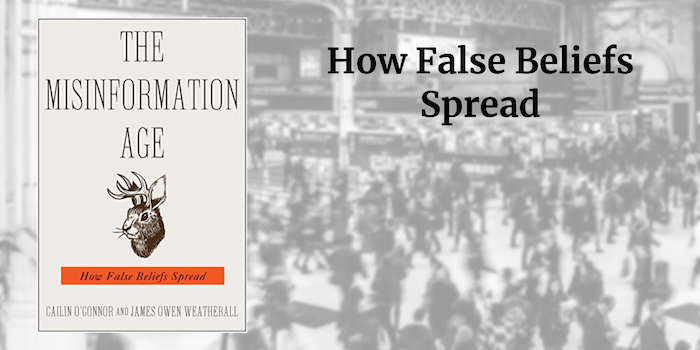 Short Version
Short Version
The Misinformation Age by Cailin O’Connor and James Owen Weatherall offers important insight for scientists, journalists, nonfiction writers, and anyone who wants to combat the spread of false beliefs.
Long Version: How Misinformation Spreads and What We Can Do About It
“Individually rational agents can form groups that are not rational at all.”
If you have had this feeling lately when reading the news, then I suggest you read The Misinformation Age by Cailin O’Connor and James Owen Weatherall.
The authors are both professors of logic and philosophy of science at the University of California Irvine. In this book, they examine how we learn from those we trust and how beliefs spread through communities. The very fact that we count on the knowledge of others means that we are susceptible to misinformation.
As they write, “Most of us get our false beliefs from the same places we get our true ones, and if we want the good stuff, we risk getting the bad as well.”
A focus on science
The book focuses on those beliefs that can be verified, or at least demonstrated with enough statistical credibility to inform a general consensus. The best place to study their spread is in the realm of science: a community that is, on the whole, in pursuit of demonstrable truths.
Like you and I, scientists arrive at their beliefs from their own experience (experiments that they conduct) combined with findings of trusted sources in their network.
The authors use a mathematical model of social learning to demonstrate how this works in a perfect world. The model serves as a starting point for examining the effect of various real-world factors that disrupt or impede the arrival at a truthful consensus. These include:
Small sample studies: Smaller studies are more likely to deliver anomalous results. (For example, if you flipped a coin ten times you cannot expect it to come up heads exactly five times. The larger the sample size, the more the results converge on the true probabilities.)
Selective sharing: Imagine that nine studies report that a drug is harmful, and one reports no harm. To reach a consensus, the scientific community (and public at large) need to be exposed to all of the results. Propagandists can skew the perception of truth by sharing and promoting only those results that support their position. The press does something similar when they only publicized the surprising, unexpected results of research.
Biased production: When industry sponsors research, it can delay or derail the formation of a truthful consensus by funding those methodologies most likely to deliver the desired results.
Beyond the world of science
By flooding us with false perceptions through trusted networks, purveyors of fake news can skew the social learning networks.
Propagandists can take advantage of the “social” part of our learning networks by building trust with people, and then spreading false beliefs. Apparently, these tactics were deployed in the run-up to the 2016 US presidential election.
Simply reporting on the fake news can contribute to the problem. According to the authors, “we generally expect evidence favoring true belief to appear more often. Sharing equal proportions of results going in both directions puts a strong finger on the scale in the wrong direction.”
The book offers suggestions for both science and journalism to counteract the effects of unintentional and active misinformation. Between inadvertent skewing of results and active manipulation, we’ve entered an age of escalating misinformation tactics. We all need to raise our games to combat the bad actors.
What writers need to know
It’s important for writers to understand where and how misinformation may spread about your topic, so that you may combat it. As writers, we also must take care not to unintentionally spread false beliefs.
These are my take-aways for writers of nonfiction topics:
- Select your sources with care, especially when citing surprising results.
- Support and share consensus opinions or rigorously tested results wherever possible; remember that people expect to see the truthful results more often than the false ones. Use your creativity to make the truth less boring than the falsehoods.
- Understand the role of trust. Earn your readers’ trust, and share and amplify the message of other trusted individuals who similarly share a commitment to the search for objective, demonstrable truth.
If you contend with misinformation in your writing, I suggest you read this book.
Find the book on Amazon or at Bookshop.
Read reviews of similar books:
Writing to Persuade by Trish Hall
The Shallows by Nicholas Carr
